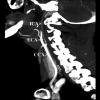Variants of cerebral arteries - anterior circulation
- PMID: 24115959
- PMCID: PMC3789932
- DOI: 10.12659/PJR.889403
Variants of cerebral arteries - anterior circulation
Abstract
Advances in imaging techniques allow for in vivo identification of abnormalities and normal variants of cerebral arteries. These arterial variations can be asymptomatic and uncomplicated although, some of them increase the risk of aneurysm formation, acute intracranial hemorrhage, play a vital role in neurosurgical planning or can be misidentified as serious pathology and medical errors. The goal of this publication is to discuss arterial anomalies of anterior cerebral circulation, their prevalence and demonstrate radiological images of some of those variants. In this article we will discuss variants of internal carotid artery, anterior cerebral artery, anterior communicating artery, middle cerebral artery, persistent stapedial artery and fenestration.
Keywords: arterial abnormalities; congenital absence of the ICA; duplication; fenestration.
Figures






References
-
- Brenner DJ, Hall EJ. Computed tomography – an increasing source of radiation exposure. N Engl J Med. 2007;357:2277–84. - PubMed
-
- Villablanca JP, Rodriguez FJ, Stockman T, et al. MDCT angiography for detection and quantification of small intracranial arteries: comparison with conventional catheter angiography. Am J Roentgenol. 2007;188:593–602. - PubMed
-
- Sanudo J, Vazquez R, Puerta J. Meaning and clinical interest of the anatomical variations in the 21st century. Eur J Anat. 2003;7(Suppl.1):1–3.
Publication types
LinkOut - more resources
Full Text Sources
Other Literature Sources
Miscellaneous
